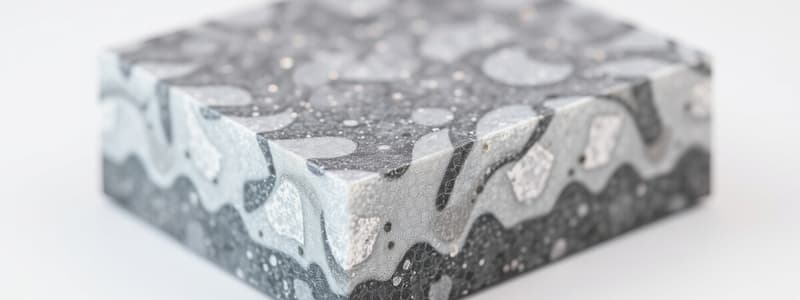Podcast
Questions and Answers
What is a dielectric material?
What is a dielectric material?
A dielectric material is an electrically insulating substance that exhibits or can be made to exhibit an electric dipole structure.
What is another name for the dielectric constant?
What is another name for the dielectric constant?
- Conductivity
- Resistance
- Capacitance
- Relative permittivity (correct)
The dielectric strength is also known as breakdown strength.
The dielectric strength is also known as breakdown strength.
True (A)
What does the electric displacement field D represent?
What does the electric displacement field D represent?
The SI unit of electric displacement is __________.
The SI unit of electric displacement is __________.
Which of the following steps is NOT involved in the manufacture of ceramic capacitors?
Which of the following steps is NOT involved in the manufacture of ceramic capacitors?
What occurs during the process of polarization in electric dipoles?
What occurs during the process of polarization in electric dipoles?
What is a dielectric material?
What is a dielectric material?
What is the dielectric constant also known as?
What is the dielectric constant also known as?
The dielectric strength is sometimes called the breakdown strength.
The dielectric strength is sometimes called the breakdown strength.
The SI unit for electric displacement is ______.
The SI unit for electric displacement is ______.
What does electric displacement (D) represent?
What does electric displacement (D) represent?
What is the relationship between electric field (E), electric displacement (D), and polarization density (P)?
What is the relationship between electric field (E), electric displacement (D), and polarization density (P)?
Which of the following is a step in the manufacturing process of ceramic capacitors?
Which of the following is a step in the manufacturing process of ceramic capacitors?
What happens to dipole moments in the presence of an electric field?
What happens to dipole moments in the presence of an electric field?
Flashcards are hidden until you start studying
Study Notes
Dielectric Material
- A dielectric material is an electrical insulator that can exhibit an electric dipole structure at the molecular or atomic level.
- All insulators are technically dielectrics, though their ability to support charge varies significantly.
- Applications include electrical insulation, sensors, and components in circuits.
Electric Dipole
- An electric dipole consists of two equal and opposite charges separated by distance, creating a vector quantity that influences behavior in an electric field.
Dielectric Constant
- Also known as relative permittivity, it is defined as the ratio of a material's permittivity (ε) to the permittivity of vacuum (ε0).
- Formula: εr = ε/ε0, where ε0 is 8.854 × 10^-12 F/m.
Dielectric Strength
- Dielectric strength, or breakdown strength, indicates the maximum electric field a dielectric can withstand before breakdown occurs.
- Breakdown can result in irreversible degradation of the material, such as melting or vaporization.
Electric Displacement
- Electric displacement refers to the charge per unit area displaced across a conductor in an electric field.
- Denoted as D, it measures the response of dielectric materials to electric fields.
- Formula: D = ε0E + P, where:
- D: Electric displacement field (C/m²)
- ε0: Vacuum permittivity
- P: Polarization density
- E: Electric field
Effects of Electric Field on Dipoles
- The electric displacement field (D) reflects how electric fields influence charge organization, including charge migration and dipole reorientation.
- The alignment of dipoles in response to an electric field is termed polarization, driven by forces acting on dipoles to align with the field direction.
Capacitors
- Capacitors store electrical energy, often using dielectric materials to separate conductive plates.
- Ceramic Capacitors:
- Manufactured by firing ceramic disks, applying electrodes, soldering leads, and coating with phenolic material.
- The electric displacement in parallel plate capacitors is given by D = Eε0 + P, indicating the relationship between electric field, permittivity, and polarization in the presence of dielectrics.
Dielectric Material
- A dielectric material is an electrical insulator that can exhibit an electric dipole structure at the molecular or atomic level.
- All insulators are technically dielectrics, though their ability to support charge varies significantly.
- Applications include electrical insulation, sensors, and components in circuits.
Electric Dipole
- An electric dipole consists of two equal and opposite charges separated by distance, creating a vector quantity that influences behavior in an electric field.
Dielectric Constant
- Also known as relative permittivity, it is defined as the ratio of a material's permittivity (ε) to the permittivity of vacuum (ε0).
- Formula: εr = ε/ε0, where ε0 is 8.854 × 10^-12 F/m.
Dielectric Strength
- Dielectric strength, or breakdown strength, indicates the maximum electric field a dielectric can withstand before breakdown occurs.
- Breakdown can result in irreversible degradation of the material, such as melting or vaporization.
Electric Displacement
- Electric displacement refers to the charge per unit area displaced across a conductor in an electric field.
- Denoted as D, it measures the response of dielectric materials to electric fields.
- Formula: D = ε0E + P, where:
- D: Electric displacement field (C/m²)
- ε0: Vacuum permittivity
- P: Polarization density
- E: Electric field
Effects of Electric Field on Dipoles
- The electric displacement field (D) reflects how electric fields influence charge organization, including charge migration and dipole reorientation.
- The alignment of dipoles in response to an electric field is termed polarization, driven by forces acting on dipoles to align with the field direction.
Capacitors
- Capacitors store electrical energy, often using dielectric materials to separate conductive plates.
- Ceramic Capacitors:
- Manufactured by firing ceramic disks, applying electrodes, soldering leads, and coating with phenolic material.
- The electric displacement in parallel plate capacitors is given by D = Eε0 + P, indicating the relationship between electric field, permittivity, and polarization in the presence of dielectrics.
Studying That Suits You
Use AI to generate personalized quizzes and flashcards to suit your learning preferences.




